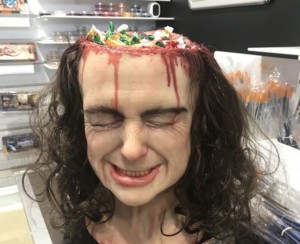About Moulage – Resources, Kits, Recipes & More
Moulage is a unique technique within the field of Healthcare Simulation that pairs artistry with medical accuracy so that healthcare learners can have the highest level of realism when treating simulated patients. Moulage can help learners suspend their imaginations and experience the vast array of emotions that can come with providing emergency care, all while practicing how to exert calm and confidence and maintain control of any medical scenario. Simulated injuries made possible by Moulage can provide added value to training sessions for emergency response teams, military personnel, and healthcare learner programs. Healthcare professionals who focus on education and training via Clinical Simulation methodologies should be familiar with various Moulage concepts and techniques, as well as how they can elevate any learning experience.
The History of Moulage
Moulage is originally a French word for molding or casting. In modern times, it has become synonymous with the adornment of Manikins with simulated illnesses or wounds to better train healthcare professionals. Using Moulage in the healthcare sphere began around the 19th century when instructors took molds of real-life medical cases to help demonstrate illnesses or wounds to future medical students. The tradition has continued to the present day.
Sponsored Content:
In medical simulation Moulage, wardrobe and props are combined with medical simulators to provide assessment clues to healthcare students and professionals. The different varieties of Moulage can enhance realism for learners. A wide range of healthcare professionals—from EMS to firefighters and military personnel to other first responders—utilize trauma Moulage, which can be particularly gory. Trauma Moulage can help learners become better accustomed to visualizing distracting injuries and overcoming their initial aversion. In this way, trauma Moulage can help healthcare trainees learn to focus on quickly triaging and assessing a patient, to reduce morbidity and mortality.
Another form of Moulage, medical Moulage, is more commonly used by nurses, physicians, surgeons, and other primary care providers. Medical Moulage can help medical professionals practice certain skills, like draining an abscess or recognizing certain conditions, such as skin infections.
Understanding the Fundamental Importance of Moulage
The level of realism presented by Moulage products can be pretty shocking, but is necessary to train Healthcare Simulation learners about what to expect in real-life situations. For example, when a person first sees a painful, distracting injury on another human being, their response can be one of dread, anxiety, or fear. However, through repeated exposures to injuries or patient presentations, Medical Simulation with Moulage can make jarring injuries less startling when they are encountered in real clinical scenarios.
Sponsored Content:
Simulated Scenarios that Can Benefit from Moulage
One of the most obvious ways Moulage can enhance the learning experience is in the case of trauma. Being told that a patient simulator has experienced a gunshot wound (and trying to picture this mentally) is much different than actually seeing, and responding to, the gunshot wound in the flesh. Trauma Moulage is considered a more complicated Moulage technique, and it usually requires a great deal of preparation.
While almost every simulated patient case dealing with trauma can be made much more realistic using Moulage, many simulation professionals are unaware of the subtler ways Moulage can enhance a non-traumatic medical scenario. Yet, simple moulage techniques, such as the application of water to demonstrate sweating due to fever or pain, or the use of blue watercolors on a Manikin’s fingers or lips to show hypotension or hypothermia, can be used for even the most elusive presentations.
Click Here to Connect to Leading Moulage Training and Product Vendors!
In the present day, as new viruses circulate the globe, medical Moulage can even help healthcare learners increase their situational awareness and practice recognizing illnesses that they have never actually encountered, such as the Monkeypox virus. Medical Moulage can also help educators teach their students about viruses and other dermatologic conditions.
Adopting Moulage Techniques in a Healthcare Simulation Setting
Moulage training is a crucial component of running an effective Simulation Center. When healthcare educators take the time to include Moulage in their simulation experiences, learners will be provided with the most realistic patient representations possible. Moulage kits for Healthcare Simulation can be purchased or built to increase the speed and efficiency of Moulage application. Moulage kits are toolkits that hold molding equipment, moulage recipes, makeup applicators, adhesives, and other cleaning supplies.
How to Start Implementing Moulage Techniques
Continuing education can be beneficial for healthcare educators who would like to introduce a Moulage practice to their Simulation Centers. Moulage workshops usually occur at Healthcare Simulation Conferences throughout the year, most notably at SimGHOSTS events worldwide. SimGHOSTS provide a number of moulage based workshops that are presented by world leaders and provide the most up to date moulage techniques.
HealthySimulation.com is dedicated to providing the latest Moulage Training news and #MedSim resources from around the world. To follow along, sign up for our free medical simulation email newsletter, follow @HealthySim on Twitter and @HealthySim on Facebook, or join our HealthySimulation.com LinkedIn Company Page!
Healthcare Simulation professionals interested in an official Moulage recipe book should read this review on the Moulage recipe book by Bobbie Merica, titled Medical Moulage: How to Make Your Simulations Come Alive. Written in 2009, this comprehensive book helps users make their Simulations come alive by offering 300 special effects recipes and scenarios for field and Clinical Simulations. Many have called this the definitive book on Moulage.
Applying Moulage Techniques in a Budget-Friendly Way
Everyday products that can be used to create Moulage in a DIY fashion include petroleum jelly, baking soda, cocoa powder, jello, paper towels, and eyeshadow. Together, these products can be used and manipulated to create Moulage representing injuries such as gunshot wounds, burns, scrapes, lacerations, eviscerations, bites, ulcers, exposed muscle, and much more. Techniques such as application of layers, color blend process, and texture replication help to create realistic moulage in clinical simulation.
A Beginner’s Kit for Moulage should Include:
- Color wheels of make up with a range of pink, red, purple, beige, green, and yellow
- Makeup sponges that have been ripped to give rough edges and lessen appearance of lines in applied wounds and bruises
- Clear/colored putty can be used to shape wounds and be blended into the manikin for color from color wheels to be applied
- Vaseline, talcum powder, silicone and cocoa which can be used to create wounds
- Simulated blood
For some patient presentations, moulage allows participants to care for rare presentations that may only be seen once or twice in a participants’ healthcare career. Moulage assists to increase realism, and suspend disbelief in clinical simulation. Moulage also prompts healthcare simulation participants to make critical decisions in real time. The use of moulage in technology such as augmented reality to demonstrate visuals such as rashes in an emerging and new trend.
Moulage has the ability to elicit emotional responses from learners and enhances psychological immersion into scenarios. This can also encourage participants to approach patients with soft skills, such as empathy and compassion. Moulage acts on participants’ senses and can allow participants to feel exposed to different patient clinical presentations. There is an art to moulage that requires patience. A lot of the time, less is more in regards to moulage. There is a tendency to want to apply a lot of special effects makeup with moulage, but often, this can result in the moulage that is too much and a distraction.
Moulage can be designed to impact all the senses in a clinical simulation scenario. Moulage may be the simplicity of a newborn baby wrapped in a moist towel or moulage blood provided in a blood bank box refrigerated as real blood would be. Moulage can include smells and tactile sensations to touch. Moulage is much more than just special effects makeup.
Resources and Recipe Books:
- Bond University Moulage Recipe Book (Stokes-Parish, Jessica B.; Roiter, Giulia, 2022).
- The Sim Tech Resources
- Laerdal Sun Recipe Book
- SimGHOSTS videos
Medical Moulage Recent Articles:

July 4th Fireworks Burn Moulage for Trauma Training

Casualties Union Celebrates 80 Years of Casualty Simulation

How to Use Low-Budget Props, Moulage to Set Healthcare Simulation Scenes

Celebrate Halloween with Realistically Spooky Healthcare Simulation Moulage Videos

Latest Clinical Simulation News From Around the World | September 2021

Moulage Secrets: Red Pigment Stain Test for Laerdal Simman 3G

How To Paint Realistic Silicone Skin: Online Moulage Course from Stan Winston School

Mayo Clinic Moulage Video Shares the Art of Making Simulated Patients Real, Plus Upcoming Instructor Courses!
Sponsored Content:


















